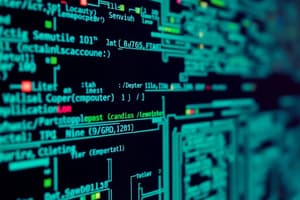Podcast
Questions and Answers
What are the primary components of a computer system?
What are the primary components of a computer system?
The primary components of a computer system are the central processing unit (CPU), memory, input/output devices, and storage devices.
Explain Moore's Law in the context of computing technology.
Explain Moore's Law in the context of computing technology.
Moore's Law states that the number of transistors on a chip would double approximately every two years while costs would decrease, enhancing computing performance.
What is the significance of Von Neumann Architecture in computing?
What is the significance of Von Neumann Architecture in computing?
Von Neumann Architecture is significant as it outlines the structure of a computer system, integrating the CPU, memory, and input/output devices into a cohesive framework for processing instructions.
Differentiate between system software and application software.
Differentiate between system software and application software.
What is a truth table and how is it used in Boolean logic?
What is a truth table and how is it used in Boolean logic?
What significant advancement in computer operating systems contributed to the popularity of personal computers in the 1980s?
What significant advancement in computer operating systems contributed to the popularity of personal computers in the 1980s?
List the primary components that make up a computer system.
List the primary components that make up a computer system.
What are the two main components of the Central Processing Unit (CPU)?
What are the two main components of the Central Processing Unit (CPU)?
How did the advent of laptops change personal computing?
How did the advent of laptops change personal computing?
What role does the Control Unit (CU) play within the CPU?
What role does the Control Unit (CU) play within the CPU?
Flashcards
Von Neumann Architecture
Von Neumann Architecture
A computer architecture with a central processing unit (CPU), memory, input/output devices, and interconnecting channels for data transfer.
Input Device
Input Device
A device that provides data to a computer system.
Output Device
Output Device
A device that displays the results of data processing by a computer system.
Computer System
Computer System
Signup and view all the flashcards
Personal Computer (PC)
Personal Computer (PC)
Signup and view all the flashcards
Graphical User Interface (GUI)
Graphical User Interface (GUI)
Signup and view all the flashcards
Moore's Law
Moore's Law
Signup and view all the flashcards
Central Processing Unit (CPU)
Central Processing Unit (CPU)
Signup and view all the flashcards
Arithmetic Logic Unit (ALU)
Arithmetic Logic Unit (ALU)
Signup and view all the flashcards
Control Unit (CU)
Control Unit (CU)
Signup and view all the flashcards
Study Notes
Computer Science Unit 1: Introduction to Computer Systems
-
Basic Computer Organization: Includes hardware (input, output, CPU, primary and secondary memory, units like bit, byte, KB, MB, GB, TB, PB), and software (system software like OS, system utilities, device drivers; application software).
-
Types of Software: System software (OS, utilities, device drivers) manages the computer, while application software performs specific tasks. Language translators (assembler, compiler, interpreter) convert higher-level programming languages into machine code.
-
Operating System (OS): Manages the computer's resources, providing an interface between hardware and software. Includes various functions like process management, memory management, file management, device management, security, and user interface.
-
Boolean Logic: NOT, AND, OR, NAND, NOR, XOR logical operations and their truth tables are fundamental for computer logic. De Morgan's laws are useful conversions for logical expressions.
-
Number Systems: Binary, octal, decimal, and hexadecimal are used to represent data in computers. Conversion between these systems is important.
-
Encoding Schemes: ASCII, ISCII, and Unicode (UTF8, UTF32) represent characters as numbers in a computer's memory.
Computer
-
A computer is an electronic device programmed to accept input, process it, and generate output.
-
A computer system comprises the computer and additional hardware and software.
Evolution of Computing Devices (Timeline)
- 500 BC: Abacus, a mechanical device for simple calculations.
- 1642: Pascaline (mechanical calculator) for addition and subtraction.
- 1834: Analytical Engine (mechanical computer), a precursor to modern computers.
- 1890: Tabulating machine (Herman Hollerith)—an important step towards computing.
- 1937: Turing Machine concept—a general-purpose programmable computer model.
- 1945: EDVAC/ENIAC: Stored program computers (John Von Neumann).
- 1947: Transistor developed, replacing vacuum tubes—drastically reduced computer size and power consumption.
- 1970: Integrated circuits (ICs) containing entire electronic circuits on a single chip—further miniaturisation and reduced cost.
Von Neumann Architecture
- Architecture of a computer involving Central Processing Unit (CPU), memory, input, output, and their communication channels.
- Electronic Numerical Integrator and Computer (ENIAC) was the first binary programmable computer using this architecture.
Moore's Law
- Prediction that the number of transistors on a chip doubles roughly every two years while cost halves.
Components of a Computer System
- Input Devices: Convert data into a digital format (keyboard, mouse, scanner, camera).
- Output Devices: Display results for humans to understand (monitor, projector, printer, speakers).
- Central Processing Unit (CPU): The "brain" of the computer that performs operations.
- Memory: Stores data and instructions for the CPU. (RAM: primary: temporary; ROM: secondary: permanent).
- Primary memory: (RAM, Cache, ROM) Data stored temporarily for immediate processing.
- Secondary memory: (Hard Disk, SSD, optical drives) Used for permanent data storage.
- System Interconnections (Bus): Transfer data between components. Includes address, data, and control buses that coordinate data movement between CPU and other components.
Computer Memory
- Memory is essential for storing data and instructions.
- Units of Memory: Bit, Nibble, Byte, Kilobyte, Megabyte, Gigabytes, Terabytes, Petabytes, etc.
- Types of Memory: Primary vs. Secondary.
Software
- System software: Manages computer hardware resources, like the Operating System. Includes utilities, device drivers, and BIOS.
- Application software: Performs specific tasks for users (e.g., word processing, web browsing).
- Language Translators: Convert high-level programming languages to machine-executable code.
Studying That Suits You
Use AI to generate personalized quizzes and flashcards to suit your learning preferences.




